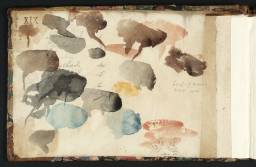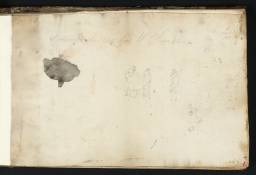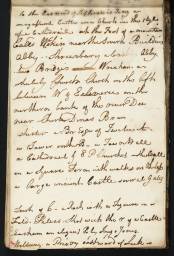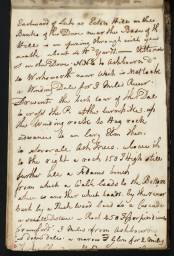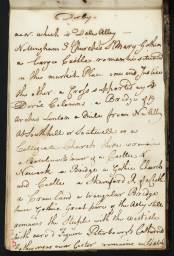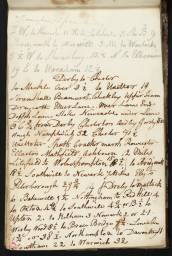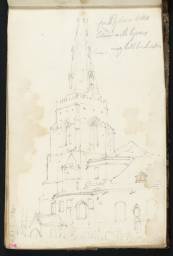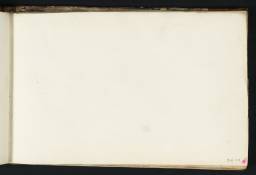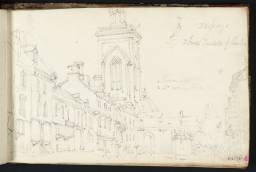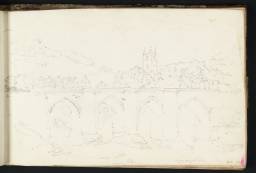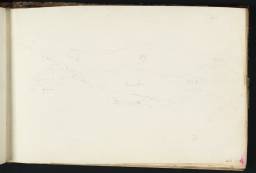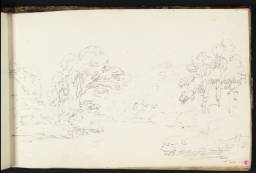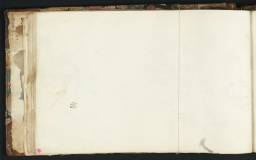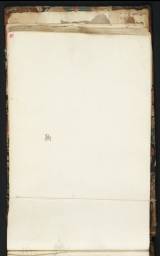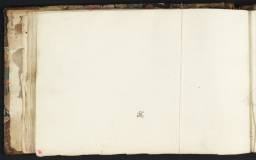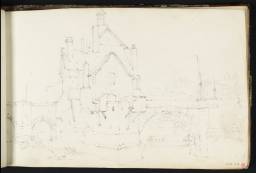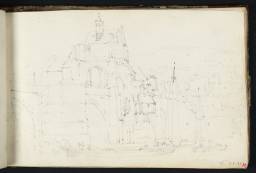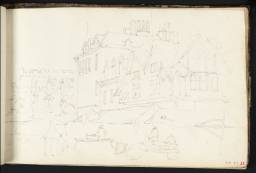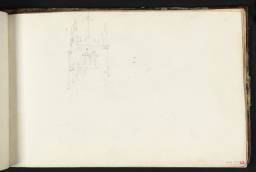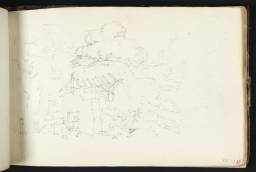Turner Bequest XIX 1–43
Sketchbook half-bound in marbled boards with leather spine and corners
43 leaves of white wove paper, waterstained throughout; page size 111 x 181 mm
Watermark ‘I WHATMAN’;
Inscribed by Turner in ink ‘Matlock | 85 Northhampton [sic] | first Tour’ on label on spine (D40749)
Numbered 290 as part of the Turner Schedule in 1854 and endorsed by the Executors of the Turner Bequest, Henry Scott Trimmer, Charles Turner, John Prescott Knight and Charles Lock Eastlake, in ink ‘No 290 Contains 21 Sketches | in Pencel [sic] – H.S. Trimmer | C Turner’ and in pencil ‘JPK’ and ‘C.L.E.’ inside back cover top centre; stamped in black ink with Turner Bequest monogram twice above left of centre and stamped in black ‘XIX’ top left (all inverted relative to the sketchbook’s foliation)
Inscribed inside front cover (D40750) by Arthur Mayger Hind in pencil ‘Leaf 27 missing | AMH 1934’
43 leaves of white wove paper, waterstained throughout; page size 111 x 181 mm
Watermark ‘I WHATMAN’;
Inscribed by Turner in ink ‘Matlock | 85 Northhampton [sic] | first Tour’ on label on spine (D40749)
Numbered 290 as part of the Turner Schedule in 1854 and endorsed by the Executors of the Turner Bequest, Henry Scott Trimmer, Charles Turner, John Prescott Knight and Charles Lock Eastlake, in ink ‘No 290 Contains 21 Sketches | in Pencel [sic] – H.S. Trimmer | C Turner’ and in pencil ‘JPK’ and ‘C.L.E.’ inside back cover top centre; stamped in black ink with Turner Bequest monogram twice above left of centre and stamped in black ‘XIX’ top left (all inverted relative to the sketchbook’s foliation)
Inscribed inside front cover (D40750) by Arthur Mayger Hind in pencil ‘Leaf 27 missing | AMH 1934’
Accepted by the nation as part of the Turner Bequest 1856
References
Turner used this book on his tour through the Midland counties to the Dee valley in North Wales in the summer of 1794. The first few pages are given over to a précis of several possible itineraries, some broadly indicated by a few principal towns, others detailed routes naming many small villages. He may have consulted a friend who knew some parts of the region intimately. He seems to have planned the trip to furnish subjects for an important commission: he had been asked to supply views for J. Walker’s Copper-Plate Magazine for which, and for three other magazines published by Walker, The Itinerant, The Ladies’ Pocket Magazine and the Pocket Print Magazine, thirty-one plates were engraved between 1794 and 1797.1 A drawing of Flint from Park-Gate (National Museum Wales, Cardiff),2 which supplied the subject for one view, is probably a page from this book. This was the first time Turner had been asked to provide a set of topographical views for publication, although he had dreamt of such a work when he made his Avon and Malmesbury drawings in 1791 (see the Bristol and Malmesbury sketchbook, Tate; Turner Bequest VI). He drew on earlier tours as well as this one, but the excursion opened up a wide new area of England to him and he made full use of it. The Marford Mill sketchbook (Tate; Turner Bequest XX) was also taken on the journey, as well as the sheaf of loose sheets catalogued in relation to this tour.
Canaletto (Antonio Canal, 1697–1768), the leading view-painter in eighteenth-century Venice, visited England in the 1740s and 1750s and made numerous drawings of London scenes, usually in a distinctive reed pen outline style which was imitated by several British draughtsmen. Edward Dayes (1763–1804), was one of the most prominent topographical watercolourists in late eighteenth-century London; see the introduction to the 1793–5 drawings of London and the Home Counties. The stylistic influence of Canaletto and Dayes, under which Turner was working in these years, is amplified unexpectedly here by an evident interest in the landscapes of Thomas Rowlandson (1756–1825), particularly noticeable in folios 24 recto and 25 recto (D00231, D00232; Turner Bequest XIX 23, 24). Rowlandson was celebrated for his humorous and satirical drawings, which he produced in large numbers.
Technical notes
How to cite
Andrew Wilton, ‘Matlock sketchbook 1794’, sketchbook, April 2012, in David Blayney Brown (ed.), J.M.W. Turner: Sketchbooks, Drawings and Watercolours, Tate Research Publication, December 2012, https://www

